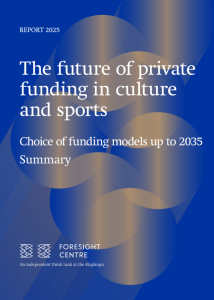The Future of Private Funding in Culture and Sports

Culture and sports rely primarily on public sector funding in Estonia. The level of funding may not increase significantly in the future, since other fields, such as social and health care, need help as well. How can we ensure the vitality of culture and sports in this situation? How much can we count on the increase in private funding and how could Estonian donation culture develop? The research stream explores the main factors influencing donation behaviour and the prospects for further development. It also examines some aspects of the socio-economic benefits of culture and sports investments.
Although there are a number of prominent culture and sports patrons, there is much more potential in private funding. The most common ways for companies to support cultural and sports institutions are donations and sponsorships. Section 49(2) clause 1 and 2 of the current Income Tax Act (TuMS) allow choosing between two tax exemption limits when donating to non-profit organisations and foundations included in the list of organisations with income tax advantages: either up to 3% of paid wages or up to 10% of the previous financial year’s profit. Currently, Estonian companies use only a small part of the maximum tax-free donation amount allowed. For instance, in 2022, a total of 27.8 million euros were donated to institutions included in the list of organisations with income tax advantages, including 4 million euros to cultural and sports organisations. However, 109,324 companies had the opportunity to donate a total of 955.4 million euros tax-free. Year by year, the volume of donations by companies has grown at around the same pace as economic growth. In 2022, though, donations increased significantly, which can be attributed to the war in Ukraine.
In previous studies (Ministry of Culture, 2023; Ernst & Young Baltic, 2024), the following findings have been highlighted.
- In Estonia, there is an established circle of companies that support culture and sports, but there are few new supporters. At the same time, new cultural and sports organisations continue to emerge and they would also like to get support. Therefore, finding new companies who have not already supported cultural organisations is the main challenge.
- Cultural and sports organisations lack the skills and habits necessary for collecting donations. Besides, collecting donations is sometimes considered taboo.
- Culture and sports are supported in varying degrees. Supporting sports is especially popular among larger companies. Funds directed to the sports sector primarily serve a marketing purpose (sponsorship) for companies.
- More and more, companies are also using alternative ways of support, such as offering products or services free of charge or with a discount.
- In the future, the donating landscape may be affected by the companies’ growing desire and need to contribute to social responsibility and sustainable development, which requires both conscious forming of practices and legislative changes.
The issues surrounding private funding involvement are related to the direct economic impact of sports and culture as well as their wider impact on society, considering not only their economic benefits, but also the improvement of health, social inclusion, community cohesion and other positive changes. Engaging in recreational and sports activities and culture may enable people to remain employed and active for longer. In 2022, only 13.1% of people aged 65 and over earned an income. If this could be increased by one percentage point with the help of sports and cultural activities, the state would receive an additional 7.1 million euros in personal income tax plus extra tax revenue from indirect taxes. (Foresight Centre, 2024)
The research stream examines the factors and trends influencing donations to the culture and sports sectors and their possible future developments. Considering the above, alternative policy options are proposed to increase private funding in culture and sports.
Primary questions of the research stream are:
- What factors and trends influence private sector donations in culture and sports? What scenarios may develop in the donation landscape in the future?
- What methods could be used to assess the socio-economic benefits of cultural and sports funding? What would be the results of different methods?
- Considering the trends and factors influencing the culture of donating, what alternative policy options could be conducive to increasing private funding? What revenues and expenses does the state expect?
Reports linked to the research
News linked to the research
-
17.04 2024Report: More private funding is needed to ensure the vitality of Estonian culture and sports
In Estonia, culture and sports are mostly reliant on public funds, while in the Nordic countries, for example, these sectors see significantly more private investment from companies and private individuals. In a recent short report, the Foresight Centre highlights how these sectors could receive over ten million euros more annually if Estonian companies raised their financial donations from the current 0.5% to 3%.

 An independent think tank at the Riigikogu
An independent think tank at the Riigikogu 
